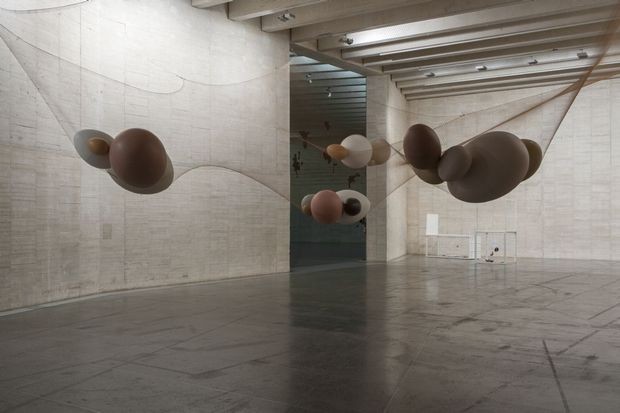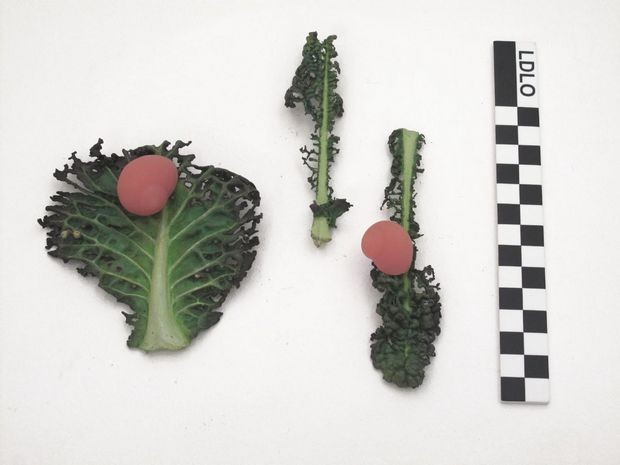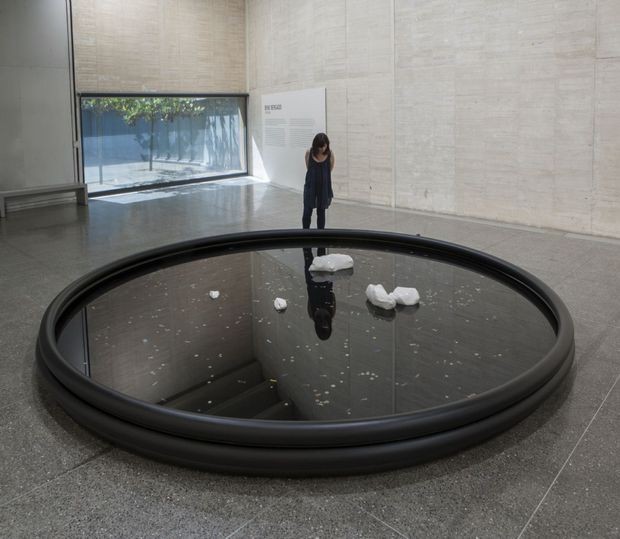Bene Bergado
Persona
25 Jun 2016 - 08 Jan 2017

BENE BERGADO. Gliptoteca (Glyptotheque), 2016. Courtesy of the artist and Espacio Mínimo Gallery, Madrid. © VEGAP, Madrid, 2016
BENE BERGADO
Persona
Halls 4-5
25 June 2016 - 8 January 2017
Curatorship: Manuel Olveira
Coordination: Helena López Camacho
Persona, is a survey exhibition affording an overview of the practice of the artist Bene Bergado (Salamanca, 1963) through thirty works,including four large new installations conceived specifically for the museum: Fosa (Pit), Trama familiar (Familiar Weave), Encuentro y Ornamento (Encounter and Ornament) and Huevos de basura III (Trash Eggs III) (all 2016).
Since the beginnings of her practice in the nineties, Bene Bergado’s work combines the essentially human with the exogenous or the foreign, giving form to improbable beings created using strange, hypothetical mutations conceived to rethink the human condition. Everything in her sculptures is at once believable yet misleading, suspect yet truthful. The complexity of her processes of depiction, the subtlety in her use of materials and the invisibility of technique are prerequisites for achieving an ontology of suspicion, the vital restlessness that inhabits her universe.
In her practice, inscribed within the long-standing tradition of sculptural iconicity, it is not strange to find the constrictions and conditioning factors to which a person is destined and the different tensions created by the imbalance between the individual and the collective, between private drives and communal rules, between a supposed selfish exacerbation of personal freedom and the repetition of behavioural patterns imposed by consumer society, big corporations and disciplinary institutions which, as Foucault argued, are the school, the church, the factory and the hospital. These metaphors infiltrate Bergado’s work and speak of the extreme fragility of the human when faced with bio-political technologies.
Borrowed from the film of the same name by Ingmar Bergman, the title of the show, Persona, makes reference both to the individual self as well as to the mask with which the self presents itself to the world. As the artist maintains, “the origin of the word persona comes from personage, the character, the mask in theatre, the theatre of life. For me, Ingmar Bergman is the epitome in the expression of emotion in cinematographic representation. I took the title of the film to ground a rethinking of the inner tangles with which our personality is woven, acted out on all personal, family, professional and social stages. At once protective nests and alienating cages, all our bonds, all our depictions, and all our little constructions both give and take away life. The boundary between home and the family story, between the room and the cell, between food and poison, between habits and rules, between economy and politics, between ornament and encounter, between power and desire, between depiction and reality, is very subtle, but this boundary is precisely our place of existence, and indeed is our very existence.”
The exhibition is, in consequence, an incisive reflection on the relationship of the individual subject with its cultural, social, technological and political environs, and on the impossibility of being and existing outside of these realms. In this tension, the artist employs sculptures and installations to create a series of depictions based on hypothesis or suppositions in which she calibrates the fragility of the human or the natural in opposition to social and economic conditioning factors. In her series, Bergadoinserts sculptures into micro-contexts that lay bare precisely these constrictions or conditioning factors. Her proposals always allude to everyday realms with subtle discontinuities and oddities; they are fragments of spaces created as the living environs of beings that personify human emotions as well as challenges related with biology or with ecology.
Even though the exhibition surveys the artist’s practice from some of her earliest output —like Proyectil modelo Freddy (Freddy Projectile Model, 1993) and the series Monitas (1999)— to more recent production conceived in response to the spatial challenge of the MUSAC architecture —like Pit and Family Weave (2016)— Persona eschews a chronological walkthrough in order to reread her work through the optic of the artist’s latest productions and the mise-en-scène at the MUSAC. In consequence, Persona is much more than a simple arrangementof works because it is conceived as a weave in which works and themes are threaded together. Therefore, the exhibition takes on the form of a grand installation, a narrative or almost a single work in which the status of the human is brought into question.
Persona
Halls 4-5
25 June 2016 - 8 January 2017
Curatorship: Manuel Olveira
Coordination: Helena López Camacho
Persona, is a survey exhibition affording an overview of the practice of the artist Bene Bergado (Salamanca, 1963) through thirty works,including four large new installations conceived specifically for the museum: Fosa (Pit), Trama familiar (Familiar Weave), Encuentro y Ornamento (Encounter and Ornament) and Huevos de basura III (Trash Eggs III) (all 2016).
Since the beginnings of her practice in the nineties, Bene Bergado’s work combines the essentially human with the exogenous or the foreign, giving form to improbable beings created using strange, hypothetical mutations conceived to rethink the human condition. Everything in her sculptures is at once believable yet misleading, suspect yet truthful. The complexity of her processes of depiction, the subtlety in her use of materials and the invisibility of technique are prerequisites for achieving an ontology of suspicion, the vital restlessness that inhabits her universe.
In her practice, inscribed within the long-standing tradition of sculptural iconicity, it is not strange to find the constrictions and conditioning factors to which a person is destined and the different tensions created by the imbalance between the individual and the collective, between private drives and communal rules, between a supposed selfish exacerbation of personal freedom and the repetition of behavioural patterns imposed by consumer society, big corporations and disciplinary institutions which, as Foucault argued, are the school, the church, the factory and the hospital. These metaphors infiltrate Bergado’s work and speak of the extreme fragility of the human when faced with bio-political technologies.
Borrowed from the film of the same name by Ingmar Bergman, the title of the show, Persona, makes reference both to the individual self as well as to the mask with which the self presents itself to the world. As the artist maintains, “the origin of the word persona comes from personage, the character, the mask in theatre, the theatre of life. For me, Ingmar Bergman is the epitome in the expression of emotion in cinematographic representation. I took the title of the film to ground a rethinking of the inner tangles with which our personality is woven, acted out on all personal, family, professional and social stages. At once protective nests and alienating cages, all our bonds, all our depictions, and all our little constructions both give and take away life. The boundary between home and the family story, between the room and the cell, between food and poison, between habits and rules, between economy and politics, between ornament and encounter, between power and desire, between depiction and reality, is very subtle, but this boundary is precisely our place of existence, and indeed is our very existence.”
The exhibition is, in consequence, an incisive reflection on the relationship of the individual subject with its cultural, social, technological and political environs, and on the impossibility of being and existing outside of these realms. In this tension, the artist employs sculptures and installations to create a series of depictions based on hypothesis or suppositions in which she calibrates the fragility of the human or the natural in opposition to social and economic conditioning factors. In her series, Bergadoinserts sculptures into micro-contexts that lay bare precisely these constrictions or conditioning factors. Her proposals always allude to everyday realms with subtle discontinuities and oddities; they are fragments of spaces created as the living environs of beings that personify human emotions as well as challenges related with biology or with ecology.
Even though the exhibition surveys the artist’s practice from some of her earliest output —like Proyectil modelo Freddy (Freddy Projectile Model, 1993) and the series Monitas (1999)— to more recent production conceived in response to the spatial challenge of the MUSAC architecture —like Pit and Family Weave (2016)— Persona eschews a chronological walkthrough in order to reread her work through the optic of the artist’s latest productions and the mise-en-scène at the MUSAC. In consequence, Persona is much more than a simple arrangementof works because it is conceived as a weave in which works and themes are threaded together. Therefore, the exhibition takes on the form of a grand installation, a narrative or almost a single work in which the status of the human is brought into question.





